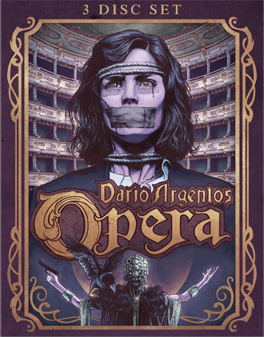 OPERA
(1987) Three-Disc Limited Edition Blu-ray
OPERA
(1987) Three-Disc Limited Edition Blu-rayDirector: Dario Argento
Scorpion Releasing
 OPERA
(1987) Three-Disc Limited Edition Blu-ray
OPERA
(1987) Three-Disc Limited Edition Blu-rayDario Argento turns cinematic gore into an aria of violence in OPERA, on three-disc limited edition Blu-ray from Scorpion Releasing.
When diva Mara Cecova – a role originally intended for Vanessa Redgrave then rewritten to be shot largely from a Steadicam POV – literally breaks a leg on the eve the opening night's performance of Verdi's MACBETH, understudy Betty (Cristina Marsillach) is thrust onto the stage to make her debut. Betty is a smash hit but she has also gained the attention of a psychotic fan who starts gorily murdering members of the production while forcing Betty to watch by taping needles under her eyes to keep her from closing them. Suspects include sadistic director Mark (Ian Charleson, CHARIOTS OF FIRE), his model girlfriend (THE CHURCH's Antonella Vitale, Argento's girlfriend at the time), adoring stage manager Stefano (William McNamara, COPYCAT), wardrobe mistress Julia (Coralina Cataldi Tassoni, DEMONS 2), and Betty's own agent Mira (Daria Nicolodi, DEEP RED); but even Inspector Santini (Urbano Barberini, DEMONS) seems a little bit off as he consults horror film director Mark for his informed perspective on the mayhem ("I think it's unwise to use movies as a guide for reality"). As the body count builds, Mark comes up with a very theatrical way of exposing the murderer who has also run afoul of the live ravens used in the production, and the closing night promises to be memorable.
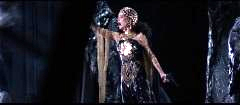
While some of Argento's fans are of the opinion that things started to go downhill with PHENOMENA, OPERA may actually be Argento's last consistently entertaining and visually-ravishing work that satisfies from the first viewing (with his later TRAUMA, THE STENDHAL SYNDROME, and arguably MOTHER OF TEARS improving with reassessment while the likes of PHANTOM OF THE OPERA, DRACULA 3D, and GIALLO may be all but unforgivable). OPERA is certainly is more extravagantly visual than his more recent work and the various absurdities are more comfortably couched in an overall off-kilter atmosphere. Ronnie Taylor's roving cinematography is ravishing throughout and, like PHENOMENA, the score is an interesting mix of heavy metal and atmospheric instrumental tracks from former Goblin composer Claudio Simonetti as well as Bill Wyman and Terry Taylor (who both contributed to PHENOMENA) and Roger Eno along with opera tracks from Verdi, Puccini, and Bellini (some of the same heavy metal tracks were reused in the Simonetti-scored PRIMAL RAGE). Despite rumors that Argento had a difficult time directing star Marsillach, she proves to be one of his most memorable leads and is well-matched by Charleson. The initial dubbing of Barberini's performance was laughed off the screen at Cannes, but his deeper, raspier revoicing lacks character. The raison d'etre of the film is memorably gory set-pieces, and the film certainly delivers with impressive technical proficiency. The make-up effects and prosthetics – executed by Franco Casagni (THE STENDAL SYNDROME) and Rosario Prestopino (DEMONS) with Sergio Stivaletti (DEMONS) providing some animatronic ravens – are quite convincing compared to the more obvious mannequin doubles of Argento's later films, and this may be due to the budget and Taylor's lighting (although the effects inserts may have been shot by second unit photographer Renato Tafuri under the direction of Michele Soavi). Tassoni – like McNamara, an American dubbed with an English accent – gets the best line of the film when she derides Mark as being someone who thinks "Verdi was a twit and Shakespeare a total asshole!" Although OPERA lacks the quirky character of BIRD WITH THE CRYSTAL PLUMAGE and the leads lack the rapport of those in CAT O'NINE TAILS, OPERA is up there with these and Argento's other top tier works such as DEEP RED, SUSPIRIA, INFERNO, and TENEBRE.
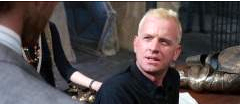 Initially
picked up by Orion for an aborted theatrical release as TERROR AT THE OPERA,
the film first showed up in English on Japanese laserdisc from Columbia with
Dolby Surround audio, but the transfer was cropped to fullscreen – the
film was shot in Super 35mm with 1.85:1 hard mattes but intended for 2.35:1
matting, so the cropping was not so severe – and the film represented
the Orion cut at 95 minutes (gore was intact because it had not been submitted
to the MPAA before the theatrical release was cancelled). Southgate Entertainment
released the film intact at 107 minutes in 1991 on VHS (along with a Blockbuster-friendly
R-rated edition). Anchor Bay released the film in 2001 in a two-disc DVD/CD
soundtrack edition featuring a THX-approved anamorphic 2.35:1 widescreen transfer
with English DTS 5.1 EX, Dolby Digital 5.1 and 2.0 Surround tracks that was
a big improvement despite somewhat grayish black levels (the first pressing
was unplayable on some players and crapped out at the layer change on others
but a replacement program rectified the situation) along with a single-disc
edition which Blue Underground would reissue in 2007. An interesting alternative
popped up in the UK from Arrow Films in 2003 featuring an Italian Dolby Digital
2.0 Surround track and English or Italian subtitles while the Dolby Digital
2.0 stereo English track was the original dub that premiered at Cannes and was
laughed off the screen (the Anchor Bay featured the second dub which revoiced
Barberini). In 2010, Arrow issued a two-disc edition utilizing the same transfer
while offering the unrated version with the 5.1 redub and the Cannes dub and
Italian tracks in 2.0 stereo as well as a reconstruction of the Orion cut with
both English dubs in 2.0 stereo.
Initially
picked up by Orion for an aborted theatrical release as TERROR AT THE OPERA,
the film first showed up in English on Japanese laserdisc from Columbia with
Dolby Surround audio, but the transfer was cropped to fullscreen – the
film was shot in Super 35mm with 1.85:1 hard mattes but intended for 2.35:1
matting, so the cropping was not so severe – and the film represented
the Orion cut at 95 minutes (gore was intact because it had not been submitted
to the MPAA before the theatrical release was cancelled). Southgate Entertainment
released the film intact at 107 minutes in 1991 on VHS (along with a Blockbuster-friendly
R-rated edition). Anchor Bay released the film in 2001 in a two-disc DVD/CD
soundtrack edition featuring a THX-approved anamorphic 2.35:1 widescreen transfer
with English DTS 5.1 EX, Dolby Digital 5.1 and 2.0 Surround tracks that was
a big improvement despite somewhat grayish black levels (the first pressing
was unplayable on some players and crapped out at the layer change on others
but a replacement program rectified the situation) along with a single-disc
edition which Blue Underground would reissue in 2007. An interesting alternative
popped up in the UK from Arrow Films in 2003 featuring an Italian Dolby Digital
2.0 Surround track and English or Italian subtitles while the Dolby Digital
2.0 stereo English track was the original dub that premiered at Cannes and was
laughed off the screen (the Anchor Bay featured the second dub which revoiced
Barberini). In 2010, Arrow issued a two-disc edition utilizing the same transfer
while offering the unrated version with the 5.1 redub and the Cannes dub and
Italian tracks in 2.0 stereo as well as a reconstruction of the Orion cut with
both English dubs in 2.0 stereo.
Scorpion Releasing's initial Blu-ray release of the film as a standard edition through Doppelganger Releasing was derived from a 2K scan of the original camera negative. The transfer boasted rich reds, deep blacks, and enhanced detail in the production design ands well as improved textures in the wardrobe. Some image stabilization issues cropped up in a couple shots but it appeared unlikely they would be fixed for Scorpion's promised two-disc Ronin Flix exclusive deluxe version until a surprise announcement; that is, another surprise announcement after the one revealing the inclusion of a third disc. The 1080p24 MPEG-4 AVC 2.35:1 widescreen presentation on the first disc – and the "open matte" 1080p24 MPEG-4 AVC 1.78:1 widescreen presentation on the second disc – is of similar high quality to the original Scorpion issue with the new stabilization and additional audio tracks seeming to have no adverse effect on the compression. The framing of the 2.35:1 version is different from the previous DVDs as a glimpse of Marsillach's red underwear is on view where it was only previously seen in the fullscreen and 1.85:1 versions, while the 1.78:1 version does sport some pleasing compositions that sometimes look too aggressively framed in the scope version (the shot-reverse-shot conversation with Marsillach and McNamara in his palazzo apartment has a more intimate feel in the 1.78:1 version).

The Dolby Stereo track's surround activity may have been somewhat compromised by the hasty redubbing, but the DTS-HD Master Audio 2.0 Stereo is of good quality in terms of directional effects while some phasing issues are present (although we have not had an opportunity to check the British Blu-ray which some reviews described as having a sort of underwater effect). The default DTS-HD Master Audio 5.1 track, on the other hand, sounds a bit more recessed and even muffled at times with the reverb sounding even more artificial than it did originally. The original Cannes dub is included as an English DTS-HD Master Audio 2.0 track but the sound is virtually monophonic, as is the Italian DTS-HD Master Audio 2.0 track which is odd since the DVD editions that had the Italian track were 2.0 surround (not sure about the Italian tracks on the other Blu-rays). English SDH subtitles have been supplied for the English dub, but the separate English subtitles for the Italian track seem to be dubtitles rather than a translation. While the Anchor Bay DVD edition replaced Simonetti's theme with the version he slightly reworked for his "Simonetti Horror Project" album and repositioned it to synchronize the fade out with the last of the credits, the Blu-ray presentation features the original track and its original synching in which the music finishes as the end credits continue to roll in silence.
The 2.35:1 transfer on the first disc is accompanied by an audio commentary by Mondo Digital's Nathaniel Thompson – who also conducted a commentary for THE CHURCH – who describes he film as "the last and finest crown jewels of Italian horror" noting the decline of Italian theatrical films in general due to competition with television (while also noting that television pre-sales resulted in the film having a higher than usual budget of eight million dollars). He covers many familiar details including the casting of Redgrave and the conflicting stories about why she left the film, the autobiographical aspect of the horror director taking on opera, Nicolodi's feelings about the film, the casting of Argento's ex-girlfriend's Tassoni and Vitale, the redubbing of Barberini, Marsillach being described as difficult, and Charleson's car accident that lead to his diagnosis as HIV+ (although he does confuse DEMONS' Peter Pitsch as Cecova's assistant with an uncredited Karl Zinny and Hungarian Opera conductor György Gyõriványi as the opera manager rather than the conductor), he does note that Argento approached Mia Sera (LEGEND) and Jennifer Connelly (PHENOMENA) before Marsillach who seemed to be an up-and-coming actress, and details about the score which included forty minutes of music from Eno of which only three cues were used. In addition to production trivia and story analysis – also noting Barberini being only two years older than Marsillach at the time made the backstory confusing – he also provides some interesting opinions of the film and its reception as well as providing some detailed discussion of the film's release history, the aspect ratios (noting that some shots do indeed work better at 1.85:1), Orion's cut and how it does work despite the cutting (also noting that Orion wanted to cut the Switzerland scenes entirely but Argento refused), as well as its history on home video. The 1.78:1 transfer on the second disc is accompanied by an audio commentary by film historian Troy Howarth which overlaps in terms of the behind the scenes anecdotes about the film but also has a few points of disagreement with the Thompson commentary (correctly noting that the opera manager was played by Antonio Juorio). More interesting is his suggestion that the film has the culmination of Argento's fascination and "fetishization" with technology and that the lesser cinematographic excesses of Argento's later films had less to do with the lower budgets than his diverting interests.
Disc one also includes "Blood Red Curtain" (21:41) an interview with director Argento who regards OPERA as one of his best films, discussing his love of opera music and his opportunity to stage a production subsequently (although not his earlier staging of RIGOLETTO that was abandoned). He covers ground familiar to Argento fans, with the opportunity to direct a Fiat commercial in Australia leading to his acquaintance with award-winning cinematographer Taylor, being refused the use of La Scala for the location and instead using the Regio Theatre in Parma, the various camera rigs used in the film, the difficulty of working with Marsillach, working with Charleson who was in a car accident during the shoot, and the ways in which the story could be an AIDS parable. Although he has denied in previous interviews that there is an autobiographical aspect to the horror director character, Argento here refers to it as "anti-biographical" in that his conception of the character is not himself but how the public perceives Argento. The clips from the film are in Italian, and it is mentioned that Argento provides the film's narration of Betty's voiced-over thoughts (although they are voiced by Marsillach herself in the English version). Also included is an interview with actress Tassoni (17:11) in New York in which she recalls Argento writing the role for her after her appearance in DEMONS 2, liking the "high energy" character, the intensity of her death scene, her follow-up appearances in PHANTOM OF THE OPERA and MOTHER OF TEARS, as well as her friendship with Simonetti – noting that she first saw DEEP RED on Italian television as a child – and her work as a multi-media artist. The disc also includes the international trailer (1:49).
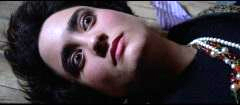 Disc
two includes Interview with actor William McNamara (51:32), the first sixteen
minutes of which is identical to the interview (16:44) from the first Scorpion
Blu-ray covering his casting by Argento while he was in Rome to shoot studio
scenes for a French/Italian miniseries THE SECRET OF THE SAHARA, working with
Charleson and Redgrave's departure from the production, his difficulty getting
his per diem payment and wanting to jump ship from the production for a role
in BRIGHT LIGHTS, BIG CITY, shooting his death scene, and not knowing how popular
Argento was until he auditioned for RESERVOIR DOGS and learned to Tarentino's
admiration for the film. The rest of the running time is devoted to a discussion
of the rest of his filmography including the cult reputation of the skiing film
ASPEN EXTREME and how he was originally considered for the Johnny Depp role
in the same writer's earlier hit 21 JUMP STREET. The disc also includes an interview
with actress Cupisti (11:10) who compares the working methods of Fulci and Soavi,
how she went from working on a stage production to the small role she has in
OPERA, and her impressions of the cast and the film. The Daemonia music video
(4:55) for Simonetti's reworking of his main theme is also on the disc.
Disc
two includes Interview with actor William McNamara (51:32), the first sixteen
minutes of which is identical to the interview (16:44) from the first Scorpion
Blu-ray covering his casting by Argento while he was in Rome to shoot studio
scenes for a French/Italian miniseries THE SECRET OF THE SAHARA, working with
Charleson and Redgrave's departure from the production, his difficulty getting
his per diem payment and wanting to jump ship from the production for a role
in BRIGHT LIGHTS, BIG CITY, shooting his death scene, and not knowing how popular
Argento was until he auditioned for RESERVOIR DOGS and learned to Tarentino's
admiration for the film. The rest of the running time is devoted to a discussion
of the rest of his filmography including the cult reputation of the skiing film
ASPEN EXTREME and how he was originally considered for the Johnny Depp role
in the same writer's earlier hit 21 JUMP STREET. The disc also includes an interview
with actress Cupisti (11:10) who compares the working methods of Fulci and Soavi,
how she went from working on a stage production to the small role she has in
OPERA, and her impressions of the cast and the film. The Daemonia music video
(4:55) for Simonetti's reworking of his main theme is also on the disc.
The bulk of the extras are on the third disc starting with a recreation of the Orion cut of the film (95:38 versus 107:35) using the new HD master. While a separate transfer of the Orion cut would have been nice – Thompson notes on the commentary that MGM has negative materials and repertory prints for that version – recreations of the cut are pretty much the norm on other Blu-ray editions and going back to Arrow's two-disc edition. The U.S. cut is framed at 2.35:1 and features only English DTS-HD Master Audio 2.0 stereo audio and no subtitles. "Notes and Nightmares" (29:47) is an interview with composer Simonetti who recalls his beginnings studying music while growing up in Brazil with his musician father, getting into progressive rock in Italy and having to find exposure at pop festivals, forming Goblin and trying to make a go of it in England where they recorded several demos over a year before returning to Italy where they attracted the notice of Carlo Bixio of Cinevox. Bixio was hired by Argento to produce the soundtrack of DEEP RED and tried to get Pink Floyd and Deep Purple before suggesting Goblin to work with Giorgio Gaslini who departed after an argument about Argento's dislike of his orchestral score. This lead to SUSPIRIA but the band had broken up by INFERNO which was scored by Keith Emerson. While Simonetti got back together with Fabio Pignatelli and Massimo Morante, they could not credit TENEBRAE to Goblin since only Pignatelli was left in Goblin (which was the same case with PHENOMENA which featured separate Simonetti and Pignatelli tracks). With regard to OPERA, he discusses some of the individual tracks including those that were not used in the film as well as cues derived from his other credits. "Who Did This and Who Am I?" (37:21) is an interview with screenwriter Franco Ferrini who pitched ideas to Argento who told him he only makes films based on his own work and thus hired Ferrini to work with him on the screenplay for PHENOMENA and then OPERA. He goes on to discuss the challenges of working with Argento, with Ferrini focused on logic and Argento on telling a story, use of POV in the film, research into Shakespeare's Macbeth and the opera, as well as the biographical aspect of Argento and Mark the horror director.
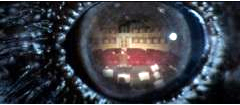
"Revenge of the Crows" (15:09) is an interview with effects make-up artist Stivaletti who was introduced to Argento through art director Maurizio Garrone – who plays the raven trainer in the film and was also in charge of the insects on PHENOMENA – and boldly stepped up and presented himself as a monster maker who could design the deformed child of PHENOMENA and then went on to learn animatronics to create the ravens with some assistance from mechanical effects technician Germano Natali (DEVIL FISH). Also interviewed with makeup artist Casagni (14:01) who first worked with Prestopino on Ruggero Deodato's THE BARBARIANS and spends much of the featurette discussing how the film's effects were achieved from the mouth stabbing and bullet through the eye to the needles under the eyes. "To Catch a Killer" (15:16) is an interview with actor Barberini who recalls being excited to be cast in DEMONS and then initially up for the role of Stefan – which Argento said was based on him – but asking for a more important part and being offered the inspector. He then discusses his ideas of characterization, working with Marsillach, and his admiration for cinematographer Taylor. "The Curse of Macbeth" (13:31) is an interview with film's publicist Enrico Lucherini who first met Argento while doing publicity for Giuseppe Patroni Griffi's LOVE CIRCLE/ONE NIGHT AT DINNER which Argento adapted from a stage play. Lucherini did publicity on all of Argento films from THE BIRD WITH THE CRYSTAL PLUMAGE to DRACULA 3D (which he disliked). He recalls bringing the Cecchi Gori Group onto OPERA and Argento's original desire to cast Giuliana De Sio (THE WICKED) in the lead before being soured on her and firing her (which lead to a lawsuit) and casting Marsillach.
"With Open Eyes" (36:10) is an interview with film critic Fabrizio Spurio who discusses the film's theme of vision in forcing the protagonist to see what she does not want to and punishing those who see too much before his own ocular punishment after being exposed. He also notes the passivity of the heroine and how others move the investigation along (and get killed for it), the film's abnormal sexual relationships (noting that the only "normal" relationship is between Betty and the killer). A strange quirk of the English subtitles on these interviews is the translation of THE BIRD WITH THE CRYSTAL PLUMAGE as THE SECRET OF THE BLACK GLOVES (the film's German title). Most interesting is "Opera Backstage" (44:32), a montage of behind the scenes footage ranging from multiple takes of simple shots like Betty running down a street in the rain to gunfire during the climax and the apartment setpiece in which both Barberini and Marsillach are shown firing the gun even though they are behind the camera, coverage of some of the effects scenes like Stefan's murder, opera bits with the live ravens, Taylor's chandelier rig, and plenty of shots where Argento seems to be either badgering Marsillach or just fervently directing her. The disc closes out with the US Theatrical Trailer (1:48) from the aborted Orion release. The cover is reversible with the more iconic black and red artwork on the inner side, a foldout poster, and a slipcover with the new artwork. A limited four hundred copies came with a VHS-style box magnet. (Eric Cotenas)